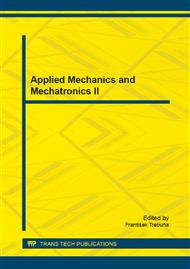[1]
A. A. Shabana, Dynamics of Multibody Systems (2nd edition), Cambridge University Press, (1998).
Google Scholar
[2]
A. A. Shabana, Computational Dynamics (2 nd edition), John Wiley & Sons, Inc., New York, (2001).
Google Scholar
[3]
K. Ogatha, System Dynamics, Prentice Hall, Inc., Englewood Cliffs, New Jersey, (1978).
Google Scholar
[4]
J. I. Meriam, L. G. Kraige, Engineering Mechanics, Volume 2, Dynamics, 3rd edition John Wiley&Sons, (1992).
Google Scholar
[5]
M. Galicki, Adaptive control of kinematically redundant manipulator along a prescribed geometrie path, Lecture Notes in Control and Information Sciences: Robot motion and control: recent developments, 2006, Vol. 335, s. 129-139.
DOI: 10.1007/978-1-84628-405-2_8
Google Scholar
[6]
M. Hajžman, Pomocný text k proniknutí do základů práce se systémem ADAMS [Auxiliary text as an introduction to ADAMS system], Information available under http: /www. kme. zcu. cz/mhajzman/download/adams_zaklad. pdf.
Google Scholar
[7]
I. Delyová, P. Frankovský, D. Hroncová, Kinematic analysis of movement of a point of a simple mechanism, in: MMaMS 2011, Modelling of Mechanical and Mechatronical Systems, proceedings of the 4th international conference, Herľany, Slovakia, 20. - 22. 9. 2011, TU Košice, 2011, s. 53-58, ISBN 978-80-553-0731-2.
Google Scholar
[8]
P. Frankovský, I. Delyová, D. Hroncová, Modelovanie mechanického systému s jedným stupňom voľnosti pohybu v programe MATLAB [Modeling of mechanical system with one degree of freedom in MATLAB], in: Transfer inovácií, č. 21, 2011, s. 71-73, ISSN 1337-7094.
Google Scholar
[9]
P. Božek, T. Pintér, Gyroscopes and Accelerometers in the Robot Control, Applied Mechanics and Materials, Vol 248, pp.584-588.
DOI: 10.4028/www.scientific.net/amm.248.584
Google Scholar
[10]
P. Kuryło, W. Papacz, Wykorzystanie pakietu Matlab Simulink w modelowaniu zjawiska tarcia, Proizvodstvo. Tehnologiâ. Ekologiâ, L. E. Švarcburg, Moskva: Moskovskij Gosudarstvennyj Tehnologičeskij Universitet Stankin, 2011, s. 207—218, ISBN: 978-5-8037-0420-1.
Google Scholar
[11]
R. Surovec, A. Gmiterko, M. Kelemen, F. Šimák, M. Fodor, I. Virgala, E. Prada and M. Vacková, Kinematic analysis of snakelike robot using obstacle aided locomotion. SAMI 2012 10th IEEE Jubilee International Symposium on Applied Machine Intelligence and Informatics 2012 Herl'any, Slovakia.
DOI: 10.1109/sami.2012.6209009
Google Scholar


